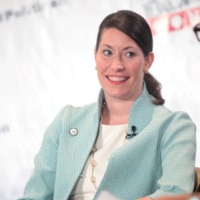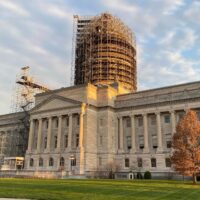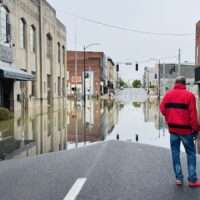Although the number of new coronavirus cases reported Tuesday in Kentucky remained high, at 532, the seven-day average of cases suggested a downward trend, and the percentage of Kentuckians testing positive in the last week dropped a bit.
Gov. Andy Beshear said it is “too early to draw conclusions,” but the daily data “at least gives us hope that we may be seeing a plateau or stabilization” because “the time period is right where the facial covering requirement is starting to kick in and help.”
Beshear ordered that masks be worn in public places, or in social gathering with people outside the household, starting on July 10 — with an expectation of seeing results after two weeks, which is roughly the incubation period for the virus. He also limited non-commercial gatherings to 10 people.
But despite those measures, new cases kept escalating, prompting Beshear to take the other two measures recommended by the White House Coronavirus Task Force: closing bars and reducing indoor restaurant capacity for the next two weeks, starting Tuesday.
Then Tuesday brought hopeful signs. The seven-day rolling average for the positive test rate fell to 5.08%, the first time it’s gone down in four days, and the seven-day average of daily new cases fell to 590. Four days before, it had been 668, more than triple the average of 220 on July 1.
Looking ahead: Beshear said he expects the state will be able to increase capacity in restaurants again in two weeks. He didn’t mention bars, which seem to have had a harder time following the mask mandate and social distancing orders.
“It is my expectation because I believe these steps will work,” he said. “Two weeks gives us a real opportunity and our hope is that we see the impact of the facial coverings before we see some of the impact on restaurants.” He said the mask mandate will likely be extended.
Asked why his latest orders were directed only at bars and restaurants, Beshear said the White House believes they are causing significant spread of the virus. According to limited cluster data provided by the state’s health departments, Beshear said 17% of the spread in Kentucky has been from restaurants and bars.
Dr. Steven Stack, the state’s public-health commissioner, again emphasized masks. “That is the single thing, if we just do it,” he said. “If we get over the cultural divide about not wearing these things, this is how we keep businesses open, we keep people working, we get people back to the activities, we get kids back to school.”
Travel risks: Beshear has also issued a travel advisory, asking Kentuckians to not travel to states with a 15% or greater positive-test rate, and to quarantine for 14 days when they get home if they choose to. The official
state COVID-19 website now includes a list of those states.
The governor said he is hearing that Kentuckians are still traveling to Florida, even with older parents, and “I need everybody that has plans to go to Florida or Georgia, Alabama, South Carolina, Texas, Arizona — cancel them.”
Beshear pointed out that the virus “continues to ravage” states around the country, noting that Florida has set a single-day record for deaths and that the virus is now killing a Texan every 6 minutes and 16 seconds.
“We have the ability to stop this before it gets anywhere close to what we’ve seen in those states,” he said, adding later, “Our goal, and I think what we have done, is to act quickly, to not let it get dire before we take the steps we need and to fully commit, to fully commit to doing what it takes to protect our people, keep our economy open and ultimately get our kids back in school.”
Beshear said 21 of Tuesday’s new cases were children under 5, the youngest a two-month-old. He said this is a nationwide trend, which could be driven by more tests, but also because more young people than ever are getting infected. “We can’t live under any illusion that kids don’t get the virus,” he said.
He said there isn’t enough data to show how children are contracting it, but “We know one driving cause is people going on vacation and taking their kids to places that they shouldn’t be taking them, and then coming back and then their kids interact with other kids.”
Trump and his drug: Nationally, one of the big COVID-19 stories Tuesday was President Donald Trump’s tweeting, more than a dozen times, in defense of hydroxychloroquine as a treatment for COVID-19, despite no evidence of its efficacy. Trump doubled down on his promotion of the drug at his press conference Tuesday.
Stack, asked about the effectiveness of hydroxychloroquine, provided a lengthy answer about its lack of efficacy:
“All the credible evidence I have seen so far is hydroxychloriquine and chloriquine are not materially helpful; they do not help enough to be worth while for coronavirus. They don’t effectively prevent you from getting the disease after you’ve been exposed to it. When you are sick, they don’t help you get better more quickly. When you are sick, they don’t help prevent you from having a bad outcome. So, maybe someday there will be some example or some narrow situation where that is not the case, but hydroxychloriquine and chloriquine, with or without the antibiotic Zithromax, which is known as azithromycin, the generic name, have not been shown to meaningfully improve your outcomes.”
Stack added, “People, when they are desperate or unwilling to listen to science and facts and evidence, do things . . .that are foolish. O.K. People were taking aquarium chemicals and ingesting them because they thought that it was somehow going to help them with the coronavirus. Ingesting aquarium chemicals will kill you, it won’t help you with the coronavirus. So please don’t do those things.”
Asked if Trump’s comments undermined public-health messaging, Stack reiterated the question as asking about when “leaders and others” communicate things that are not supported by science.
“I would continue to urge everyone in the public, please find people who have dedicated their lives and their professional lives to studying and learning about these things that are important, and listen to credible sources,” he said. “I would look to a physician or a public-health expert to advise me on public health stuff. I don’t take my car to a medical doctor to get fixed.”
In other COVID-19 news Tuesday:
-
Beshear reported that 584 Kentuckians are in hospitalized with COVID-19 and 115 of them are in intensive care, declines of 4 and 12% from Monday, respectively.
-
He reported that 77 more long-term care residents and 31 more staff had tested positive for the virus, and attributed nine more nursing-home deaths to COVID-19.
-
Beshear reported 10 new deaths from the virus, bringing the total to 719: a 74-year-old woman from Butler County; an 84-year-old man from Fayette County; a 37-year-old man from Lyon County (an inmate at the Kentucky State Penitentiary); a 73-year-old woman from Oldham County; and three each from Jefferson County (two women, 86 and 87, and a man, 82) and Logan County (two women, 89 and 101, and a man, 83).
(Kentucky Health News is an independent news service of the Institute for Rural Journalism and Community Issues, based in the School of Journalism and Media at the University of Kentucky, with support from the Foundation for a Healthy Kentucky.)
Melissa Patrick is a reporter for Kentucky Health News, an independent news service of the Institute for Rural Journalism and Community Issues, based in the School of Journalism and Media at the University of Kentucky, with support from the Foundation for a Healthy Kentucky. She has received several competitive fellowships, including the 2016-17 Nursing and Health Care Workforce Media Fellow of the Center for Health, Media & Policy, which allowed her to focus on and write about nursing workforce issues in Kentucky; and the year-long Association of Health Care Journalists 2017-18 Regional Health Journalism Program fellowship. She is a former registered nurse and holds degrees in journalism and community leadership and development from UK.






